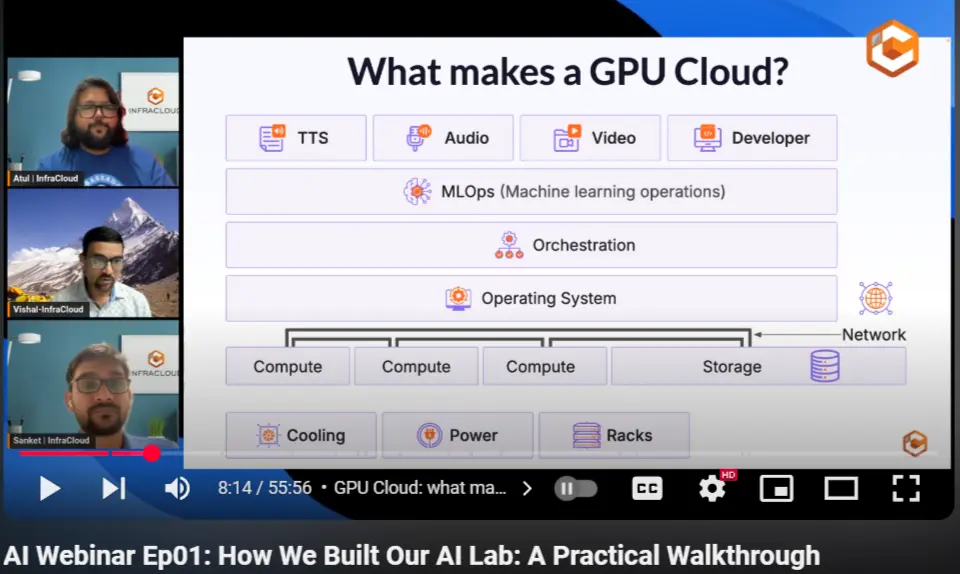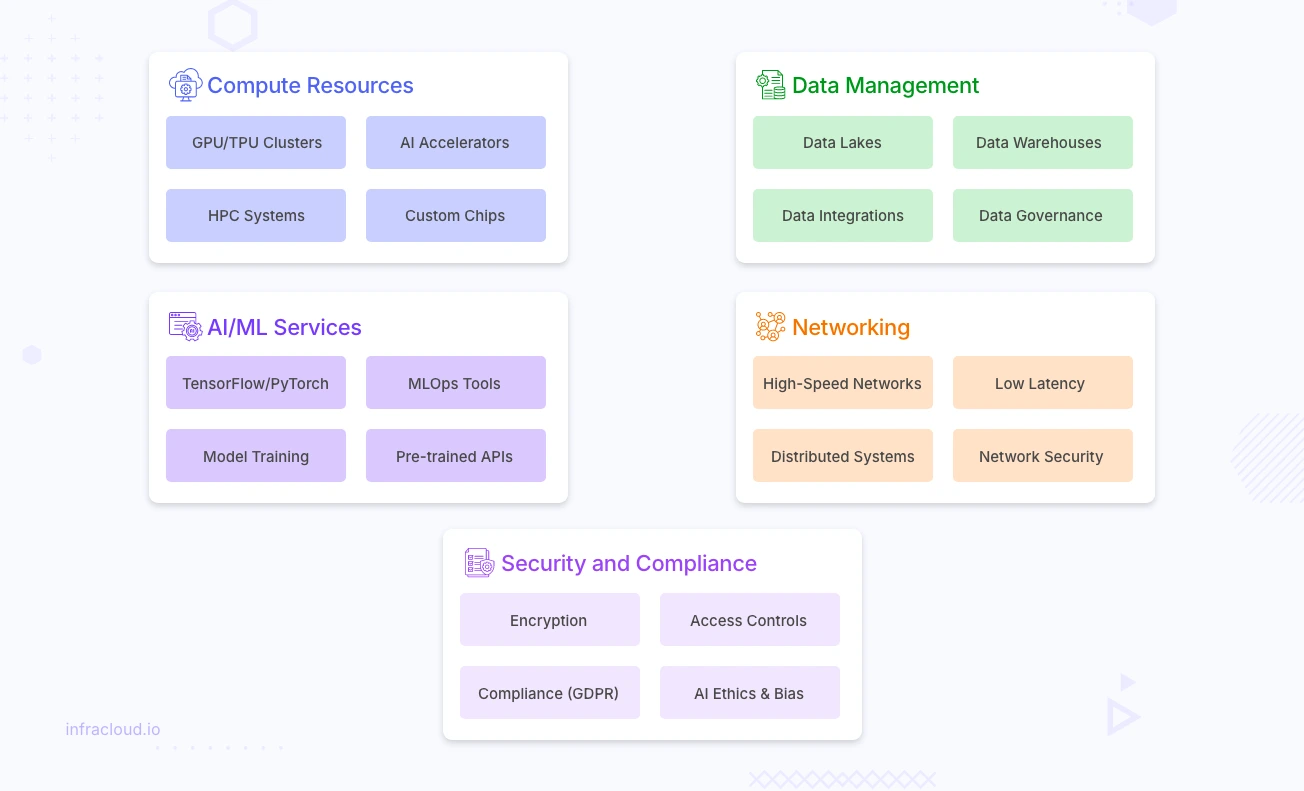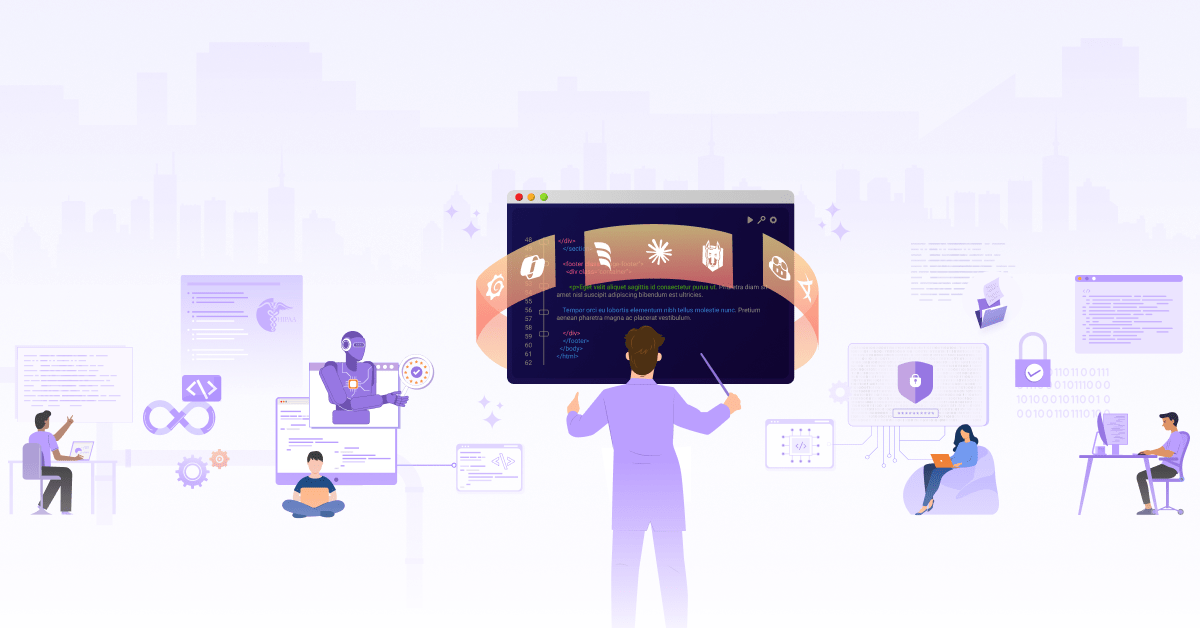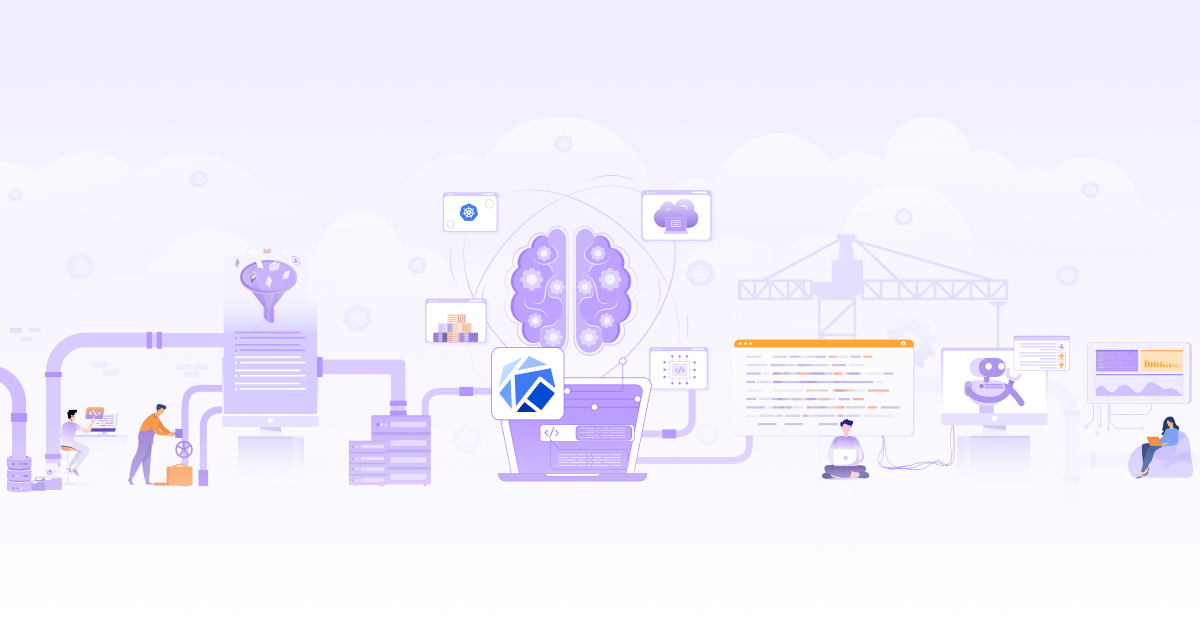
AI Cloud: What, Why, and How?

The rapid growth of AI applications across industries has led to significant changes, particularly with the adoption of deep learning and generative AI, which provide a competitive advantage in industries such as drug discovery in pharmaceutical R&D and fraud detection in banking and e-commerce.
However, these advancements require substantial infrastructure that on-premises solutions often fail to support due to high initial costs, inflexible resources, inefficient GPU management and the rapid evolution of GPU hardware technologies. Additionally, increasing data requirements and the need for global availability complicate the ability to meet the dynamic demands of modern AI workloads.
Scaling AI applications on-premises infrastructure struggles with the computational power, memory, and storage required for AI workloads, leading to inefficiencies. Large datasets can cause delays, while geographic limitations hinder global scalability. Resource competition and slow networking further disrupt performance in shared environments.
This blog post introduces you to AI Cloud, what it is, and how it allows you to deploy and scale your AI workloads. We’ll understand the various components of AI Cloud, migration strategies and challenges.
What is AI Cloud and what are its key features and benefits?
AI Cloud is a suite of cloud services that provide on-demand access to AI applications, tools, and infrastructure. It enables organizations to leverage pre-trained models and advanced AI functionalities, including computer vision, natural language processing (NLP), and predictive analytics, without the need for complex system development.
The key features of AI Cloud are:
- Provides a robust platform that efficiently manages and allocates computing resources to optimize performance and scalability.
- Offers capabilities for organizing, storing, and managing training datasets to ensure data quality and accessibility.
- Features advanced tools that streamline the development and deployment of machine learning (ML) models, reducing time and complexity.
- Delivers support for real-time predictions, enabling businesses to respond to dynamic data inputs and user demands quickly.
- Includes a diverse range of AI services that are easily accessible via APIs, allowing organizations to integrate advanced functionalities into their applications seamlessly.
This flexibility allows businesses to scale their AI usage according to demand, making it a cost-effective solution that improves efficiency and drives innovation. By offering the tools to harness the potential of AI fully, AI Cloud empowers businesses to optimize performance while maintaining data sovereignty. It eliminates the need for significant infrastructure investment, enabling easier access to cutting-edge AI capabilities.
| Feature | AI Cloud | On-Premise |
| Setup Cost | Low, pay-as-you-go | High upfront investment |
| Flexibility & Scalability | High flexibility with a wide range of services, Scalable on-demand, | Customizable, but limited scalability and requires hardware upgrades |
| GPU Management | Managed automatically | Requires manual management |
| Deployment Speed | Quick with pre-built tools | Slower, custom setup is needed |
Why AI Cloud is important?
The increasing complexity of the AI models, added to the growing demands of data-driven applications, has underlined limitations in traditional infrastructures. Businesses are increasingly deploying AI to enable user personalization, automate processes, etc. These applications require immense computational resources, low latency, and scalability - all of which are attributes of the AI Cloud uniquely positioned to provide.
It helps organizations tackle the modern demand to become agile and competitive, with the facility for training, deployment, and optimization of their AI workloads. Emerging AI-driven solutions, like intelligent agents for smart contextual Q&A, are revolutionizing customer engagement by providing real-time, personalized interactions that adapt to user needs, improving efficiency and satisfaction.
Compared to on-premise setups or traditional cloud workloads, AI Cloud promises unmatched scalability, flexibility, and cost efficiency. It provides a pay-as-you-use pricing model that eliminates heavy upfront investments while ensuring that resources will be dynamically allocated according to demand. In addition, AI Cloud accelerates the time-to-market by simplifying infrastructure management and providing high-performance tools to train and deploy models.
It is also powered by robust security, compliance, and performance optimization, ultimately allowing to scale AI capabilities globally in a reliable and efficient manner making it the future of hosting demanding workloads.
How AI Cloud work?
Here is how the AI cloud work:
- AI Cloud offers GPU clusters, scalable storage, and low-latency networking, optimized for handling large datasets and complex models, managed with the advanced virtualization and containerization tools.
- The platform divides workloads across multiple nodes, enabling rapid processing of data and algorithms with distributed computing.
- Built-in tools streamline training, testing, deployment, and monitoring, freeing users to focus on innovation rather than infrastructure.
- AI Cloud quickly ingests, preprocesses, and stores large volumes of data, accelerating machine learning model training.
- APIs, hybrid cloud configurations, and data migration tools allow smooth integration with existing IT systems and legacy workflows, modernizing operations without disruption.
- The platform supports easy scaling across various applications, making it adaptable to different applications and operational needs.
- Operates on a pay-as-you-go model, automates processes for enhanced efficiency, and continuously refines AI models to meet evolving business challenges.

Watch our webinar on building an AI cloud, where Vishal and Sanket explained what makes a GPU cloud.
Core components of AI Cloud
Compute resources
AI Cloud relies on robust compute infrastructure tailored for demanding workloads. High-Performance Computing (HPC) clusters provide the raw power necessary for training and running AI models. GPUs and TPUs offer accelerated processing, drastically reducing the time required for computation-intensive tasks like deep learning. Specialized hardware, such as AI accelerators and custom chips, further optimize performance, while power and cooling systems support the high-density requirements of these components, ensuring reliability and efficiency.
Data management & storage
AI Cloud handles data with advanced data lakes and warehouses designed to store and manage vast datasets. Data ingestion and integration tools streamline data flow from various sources while governance and security frameworks protect data integrity and privacy. These systems ensure data is accessible, compliant, and ready for AI model training and inference.
AI/ML services & frameworks
AI Cloud offers a plethora of services that support the entire AI/ML lifecycle, from training and deployment to simplifying for developers to work on model development, while pre-trained models and APIs accelerate the integration of applications. MLOps enables efficient model monitoring, versioning, and updates to maintain and scale AI systems seamlessly over time.
It supports the AI/ML lifecycle with frameworks like TensorFlow, PyTorch, and JAX for training, services like SageMaker, etc., for deployment and MLOps tools like MLflow, Kubeflow, and TFX, and pre-trained APIs like Google Vision, AWS Rekognition, and OpenAI for seamless integration.
Networking & connectivity
Efficient AI operations frequently depend on high-speed networks, particularly when managing large datasets and distributed workloads. AI Cloud solutions focus on optimizing network architectures to reduce latency and ensure consistent performance for demanding AI applications. Secure and reliable connections are prioritized, safeguarding data during transmission and supporting real-time AI applications.
Security & compliance
AI Cloud incorporates robust measures to address data privacy and security by using encryption, access controls, and advanced protocols to protect sensitive information. It complies with industry regulations such as GDPR and HIPAA, ensuring data is handled responsibly. It also is committed to AI ethics and reducing bias, with strategies to maintain fairness and transparency in AI models. These are integral to its design, helping organizations adopt AI responsibly and sustainably.

Understanding the underlying infrastructure and optimization strategies is necessary for efficient resource utilization, minimizing latency, and maximizing the performance of AI models while adapting to the evolving demands of various applications and workloads.
Challenges and mitigation strategies in AI Cloud
Even though AI Cloud has plenty of benefits, it also brings some challenges that need to be addressed.
Challenges in AI Cloud adoption
Several major challenges in adopting AI cloud:
- Technical integration and infrastructure setup: Integrating AI workloads with existing IT systems and establishing the right cloud infrastructure poses significant challenges, as misalignment can lead to delays and performance issues. Selecting appropriate hardware, storage, and networking configurations is essential for smooth deployment and optimized resource management. InfraCloud’s AI cloud simplifies this by offering pre-configured AI cloud solutions that seamlessly integrate with existing systems, reducing complexity and ensuring optimal performance while adhering to data residency and compliance requirements.
- Cloud dependency and vendor lock-in: Heavy reliance on a single cloud provider can create challenges such as vendor switching, unforeseen costs, reduced flexibility, and complicated scaling efforts.
- Cost management: AI workloads often require significant resources, and without careful planning, costs can escalate quickly. Scaling resources efficiently while maintaining financial transparency is a persistent challenge.
- Data privacy, security, compliance, and prompt injection: Handling sensitive data in the cloud necessitates stringent security measures like encryption and access controls to protect against breaches. Compliance with data privacy regulations (e.g., GDPR, CCPA) is crucial. Our AI cloud ensures security frameworks and compliance readiness are in place, helping handle data responsibly while meeting global regulatory standards.
- Power, cooling, and environmental impact: The high computational power required by AI models results in increased energy consumption and cooling needs, presenting logistical and environmental challenges, especially for on-premises or hybrid setups.
- Ensuring reliable AI outcomes: AI models are prone to generating unreliable or hallucinated results. Building reliable validation pipelines, monitoring outputs, and continuously refining models are critical to delivering dependable outcomes from AI applications.
- High initial investments (CAPEX): Transitioning to AI Cloud often requires substantial upfront costs for private or hybrid configurations, including specialized hardware and skilled personnel.
Mitigation strategies
The mitigation strategies below can help you with seamless implementation and optimal performance.
- Security and compliance: Use advanced encryption and regular audits to secure data. Adhere to privacy regulations to build trust.
- Optimized scalability and cost control: Choose scalable cloud solutions with transparent pricing; utilize cost-monitoring tools for resource adjustments.
- Flexible cloud architectures: Adopt hybrid or multi-cloud strategies to avoid vendor lock-in and enhance flexibility.
- Energy efficiency and sustainability: Implement energy-efficient hardware and optimize workloads to reduce costs and environmental impact.
- Outcome reliability practices: Integrate rigorous testing and monitoring to ensure reliable AI outcomes.
- CAPEX reduction and scalability: Leverage the cloud’s pay-as-you-go model to minimize upfront costs while validating ROI.
- Preventing prompt injection: Implement strict input validation and monitoring systems to mitigate malicious attempts to manipulate AI models. Regularly update training datasets to counteract injection patterns.
Major AI Cloud platforms
| Feature | Amazon Web Services (AWS) | Microsoft Azure | Google Cloud Platform (GCP) | IBM Cloud |
| AI/ML Services | SageMaker for training and deployment | Azure Machine Learning | Vertex AI for training and deployment | Watson Studio and Watson Machine Learning |
| Model as a Service | AWS Bedrock, Amazon Polly, Amazon Rekognition | Azure Cognitive Services, Azure AI Models | AI Hub, AutoML, Vertex AI Models | Watson AI services, Watson Visual Recognition |
| Compute Resources | EC2 Instances, Elastic Inference, AWS Lambda | Virtual Machines, Azure Kubernetes Service | Compute Engine, TPUs, GPUs | Bare Metal Servers, Cloud Functions |
| Data Storage | S3, Redshift, Data Lake Formation | Blob Storage, Data Lake Storage | Cloud Storage, BigQuery | Cloud Object Storage, Db2 |
| Security & Compliance | Extensive compliance certifications (GDPR, HIPAA) | Compliance with industry regulations (GDPR, HIPAA) | Google Cloud Security, SOC 2, GDPR | IBM Cloud Security, IBM X-Force |
| Integration & Tools | AWS AI tools, ML Frameworks (TensorFlow, PyTorch) | Pre-built models, Cognitive Services | TensorFlow, AutoML, TensorFlow Extended | Open-source tools, Integration with other IBM systems |
Emerging AI cloud solutions offer specialized services, including custom AI chips, edge computing capabilities, and decentralized data storage, paving the way for more tailored and innovative AI applications.
Real-world applications and industry use cases of AI Cloud
AI Cloud is revolutionizing industries by providing scalable, flexible, and efficient solutions for complex problems. Here are some real-world examples of how businesses are leveraging AI Cloud:
- Healthcare: Healthcare providers use AI Cloud to train diagnostic models across institutions while maintaining data privacy. It enables the use of federated learning, securely and efficiently managing the complexities of distributed model training.
- Manufacturing: Companies use AI Cloud platforms to create digital replicas of their factory operations to enable real-time analysis of sensor data to optimize production processes and improve efficiency. Centralized cloud platforms make it easier to connect data from multiple facilities without the need for expensive local infrastructure.
- Financial services: Banks benefit from AI Cloud’s ability to dynamically scale computing resources. Top Companies use AI infrastructures to process millions of trading data points during peak trading hours, ensuring cost-effective elasticity.
- Retail: Global retailers utilize AI Cloud’s geographic distribution for efficient operations. AI infrastructures are used to deploy low-latency inventory management models tailored to each store’s region, streamlining compliance and updates.
Final words
AI Cloud represents the next frontier in AI-driven innovation, offering a powerful and scalable infrastructure to meet the growing demands of modern applications. By offering access to robust computing resources, specialized AI/ML services, and a flexible framework, AI Cloud empowers businesses to accelerate innovation, enhance their competitive edge, drive automation, improve user experiences, and make informed decisions.
With continued advancements in machine learning, data processing, and infrastructure optimization, the role of AI Cloud will only grow in importance, driving advancements across various industries and shaping the future of technology.
Ready to take the next step in AI-driven innovation? If you’re looking for experts who can help you scale or build your AI infrastructure, reach out to our AI & GPU Cloud experts.
If you found this post valuable and informative, subscribe to our weekly newsletter for more posts like this. I’d love to hear your thoughts on this post, so do start a conversation on LinkedIn.
Stay updated with latest in AI and Cloud Native tech
We hate 😖 spam as much as you do! You're in a safe company.
Only delivering solid AI & cloud native content.











